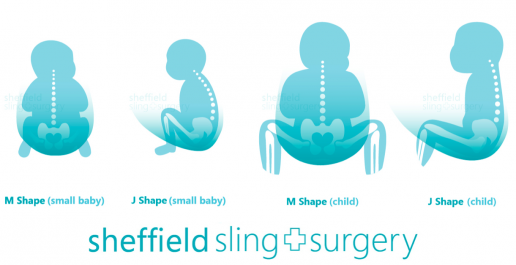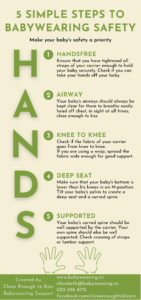If you are a mum like I am, I’m sure your baby’s safety is pretty high up on your priority list. It is something that is very hard to imagine, when you are pregnant with your first child: how your whole universe will all of a sudden evolve around this tiny human being and how you would do basically anything to keep it safe from harm.
Most mums (and dads of course) use a carrier to keep their little one close, without needing to use both hands all the time to hold baby. For this, carriers are amazing. Suddenly you can go for a walk, chase after your toddler, play with your older children or even get some of that housework done.
But even the best carrier is only as good as the caregiver who knows how to safely use it. You will find lots of “rules” for safe babywearing in the world of babywearing. However, I prefer to use guidelines as rules can’t cover all possibilities and may not work for some situations.
Because sometimes it is nice to have a visual reminder (hello early foggy babybrain days) I have created a simple PDF, which you can download for FREE at the end of this post.
What does HANDS stand for?
If you are a little familiar with babywearing safety you may have heard of TICKS, which a lot of people follow as a safety guideline. There is nothing wrong with using the TICKS safety checklist, but during my training with Slingababies NZ I was made familiar with the HANDS safety guideline and have since then only used this safety guideline.
I will explain below, why I like to use HANDS instead of TICKS, but let’s have a look first what HANDS means:
H – handsfree
Well, the whole point of babywearing is that you can have your hands free. If using your carrier correctly, you should be able to take both hands off your baby and still feel like the carrier will hold your baby like you would with your hands.
If you feel you can’t take your hands off baby, you should check the fit of your carrier. Are there any buckles you can tighten or do you need to tighten some of the fabric from your wrap or sling? When you are using a soft structured carrier, your baby may be a little too small for the carrier and therefore doesn’t feel secure in it. When using a stretchy wrap, woven wrap or ring sling you may want to fold the top rail at baby’s neck over a thin piece of fabric (small muslin cloth) to create some support for the neck.
A – airway
One of the most important safety issues are the airways for little babies. Baby’s airways should always be kept clear for them to breathe without trouble.
Important questions you can ask yourself:
- Is your baby’s head off its chest? When babies have their chins on their chest their airways may become constricted, which means baby can’t breathe properly. Especially when baby falls asleep and his head slumps forward, gently tilt the head back. When using a wrap, you can tuck the head under one of the cross passes.
- Is any clothing obstructing the airways? Make sure that neither you nor baby wears clothing that can bunch up in front of baby’s face. This is particularly important in cold weather, when everyone wears multiple layers of clothing.
- Are you wearing baby high enough? This is usually only a question that women should ask themselves as they are the ones with soft breasts, where baby’s nose can be buried in. This is where the saying “close enough to kiss” comes in. When your baby’s head is high enough for you to easily kiss it, then his face will be on the bony part of your chest (your sternum) instead of lower down between your breasts. Men, however, can wear babies lower without any trouble as they don’t have soft breast tissue.
- Can you easily see your baby’s face, when glancing down your carrier? If you can, then baby’s airways will be free and there will be enough airflow for them to breathe properly.
N – knee to knee
Ideally the carrier should support your baby from knee to knee. This means that the fabric of the carrier should spread from one knee pit to the other but not further. When your baby’s legs are supported like this, it will be easier to get them into the desired M-position. The M-position means that baby’s knees are higher than his bottom, like the high points of an “M”.
For soft structured carriers this may be harder to achieve as most carriers have a fixed width of the seat. If the fabric is wider than knee to knee it should be cinched (made smaller) to the correct width. If the fabric does not support all the way from knee to knee some other form of support (such as a scarf) can be added. This is especially important for babies who are not yet able to stand and walk as the ligaments and muscles in their legs are not yet strong enough to support the weight of their own legs well. Luckily, there are lots of great soft structured carriers on the market now, where the width of the seat can be adjusted easily.
For stretchy wraps, woven wraps and ring slings it is important to remember to spread the fabric all the way from knee pit to knee pit to get the full support of the carrier and to achieve the M-position.
D – deep seat
Creating a deep seat for your baby’s bottom is the other half of getting baby into the M-position. But how do you get your baby into this position? This is what people often struggle with.
First of all, you should check if the carrier supports baby from knee to knee. Then lift the knees up a bit, which often already creates a deeper seat for your child. If this doesn’t help enough you can help by tilting your baby’s pelvis. To do this, you can either reach with both hands inside the carrier and move your baby’s bottom down and towards you. Or you can reach into the sides with your thumb and forefinger to move baby’s legs a little towards you and upwards at the hip sockets.
Why do people keep on talking about the M-position? I like to compare this position to sitting in a nice comfy deep chair, where you are likely to sit with your bottom deeper than your knees. Can you imagine yourself in this position? Now, imagine sitting on a high bar stool with your legs hanging down. Which chair would you choose if you had to sit on it for longer? Probably the deep comfy one, right? So, while it is not necessarily dangerous for your child to not have a deep seat and be supported from knee to knee, it will be much more comfortable for them and they will be happy for longer in the carrier.
S – supported
The spine of a newborn has a curved “J” shape and will gradually straighten until baby is 12 months old. When babywearing the natural shape of baby’s spine should be well supported. This means that the carrier shouldn’t be overly tight and therefore straighten the spine out of its “J” shape, but it also shouldn’t be too loose, otherwise baby might slump.
Apart from supporting your baby’s spine, you also shouldn’t forget about supporting your own spine. If your carrier allows for crossed straps, then I can highly recommend crossing your straps. This will help distribute your baby’s weight more evenly across your back. When using a wrap, ring sling or meh dai you can also spread the fabric, which will again distribute the weight across your back. Some soft structured carriers have a special lumbar support which can help caregivers with lower back problems.
M-Shape and J-Shape
In this picture from the Sheffield Slingsurgery you can see how a small baby and an older child are ideally positioned in a carrier to create the M-shape with their bottom and legs and the J-shape with their backs.

Why I prefer to use HANDS instead of TICKS
After I have explained in detail what HANDS stands for, I will quickly tell you what TICKS stands for before explaining, why I prefer to use HANDS.
TICKS stands for Tight, In view at all times, Close enough to kiss, Keep chin off the chest and Supported back.
Those are all great points to look out for, but I think that the three points in the middle (in view at all times, close enough to kiss and keep chin off the chest) can be easily combined under airways as they all relate to making sure that baby’s airways are clear. As you may have noticed above, I have included all three points under the heading “airways”.
I like that HANDS also includes knee to knee and deep seat as the M-position is important, especially for younger babies. When baby has its legs and bottom in the M-position the spine will also be in the ideal J-shape.
Download your own HANDS reminder
If you also like to use the HANDS safety checklist, then simply click on the picture below and download the reminder for FREE.

